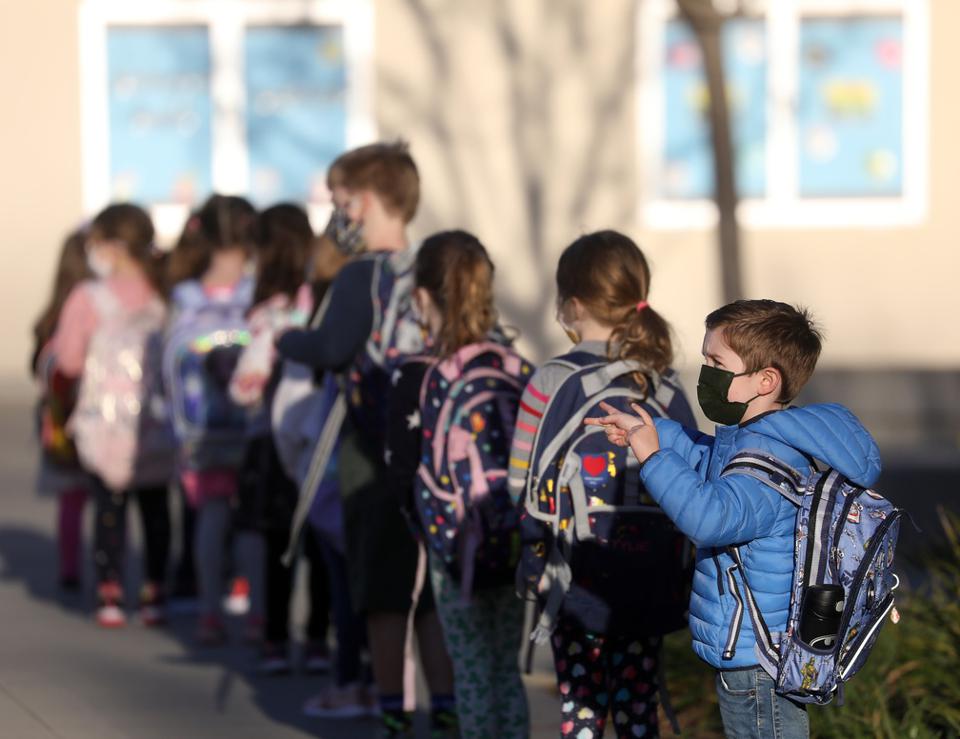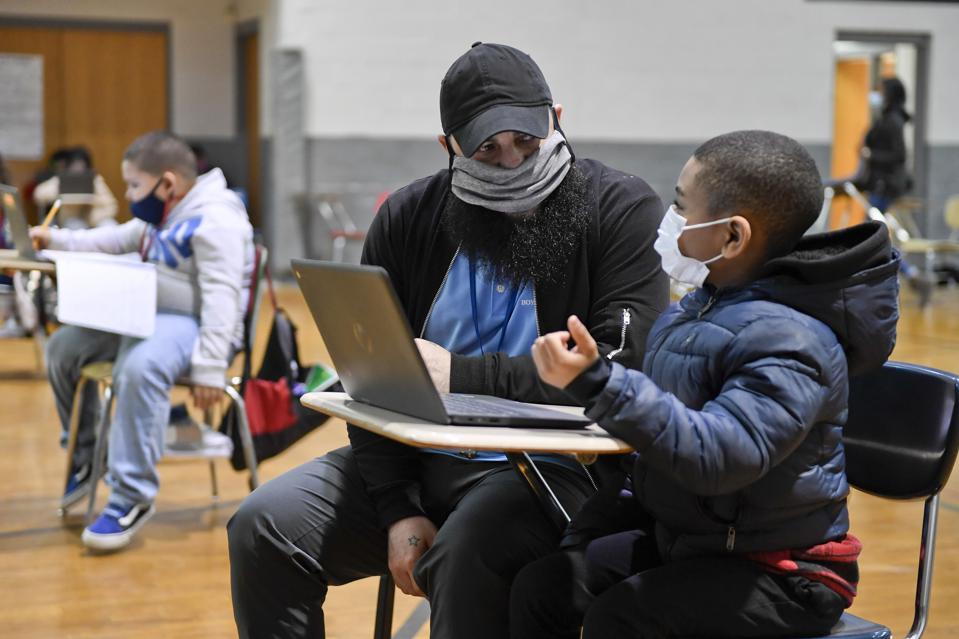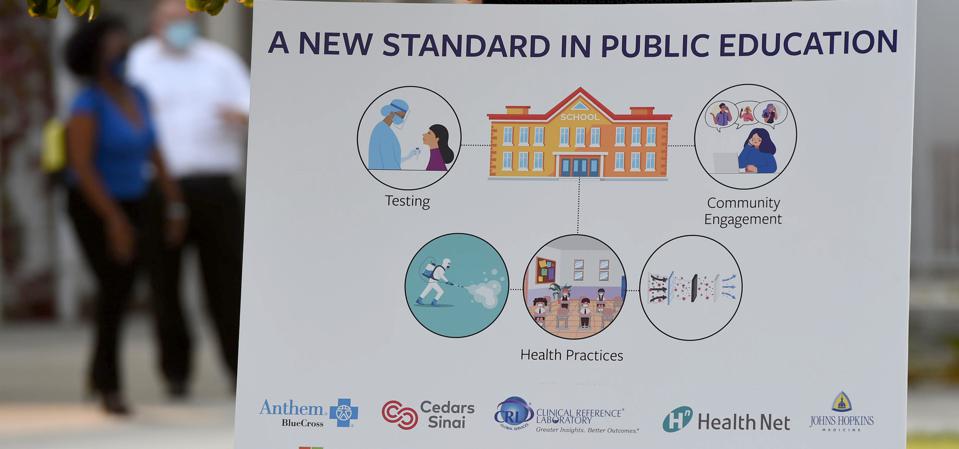

February 26, 2021
By Jeanne Allen, Founder and CEO of CER

DANVILLE, CA – FEBRUARY 10: Kindergarten students line up at Greenbrook Elementary School before the first day of in class instruction on Wednesday, Feb. 10, 2021, in Danville, Calif. The San Ramon Unified School District reopened classrooms to students in a multi-phase, hybrid plan, and expects to see 10,000 students in grades pre-kindergarten through 6th grade return to campuses by next Wednesday. (Aric Crabb/MediaNews Group/East Bay Times via Getty Images)
MEDIANEWS GROUP VIA GETTY IMAGES In Pataskala, Ohio, Watkins Memorial High School has been open all year. According to CNN, teachers, staff and students have all heralded what has occurred there. “’The spread is not there. We just set our expectations and the children have followed it, and it’s been fantastic,’” said one teacher. And the Superintendent of the Southwest Licking School District told CNN she was happy to show anyone what’s worked so well.
These and other reasons are why Ohio Governor Mike DeWine has mandated in-person learning next week.
But in Montgomery County, Maryland, Teachers staged a protest against demands that they return to school, with a few hundred slated to come Monday, and many more later this month. Bethesda Magazine reported that “The teachers union called the reopening plan ‘irresponsible’ and took a vote of ‘no confidence’ last week.”
Some might wonder what is so different about these two communities in Ohio and Maryland. The answer? About 500 miles. The reality is there is no difference between their conditions. The Montgomery County schools are slightly bigger than the Licking School District, but they’ve not opened to date, with smaller numbers. Yet, they are acting as if they are in another world, accusing district and state officials of failing to mind their safety, when there is an abundance of evidence that being in school can be safe for all.
Many are asking, if many schools have opened, and the CDC says in-person learning is safe, why are most districts still remote? Here’s my take on that, and a few additional questions and answers weighing heavily on the minds of most Americans.

Reading, PA – January 19: Jordan Rodriguez, director of the Mulberry Street club, works with Santana Sanford, 7, a second grade student, as he does his school work on a laptop computer. At the Mulberry Street location of the Olivet Boys and Girls Club in Reading Tuesday morning January 19, 2021 where the club has resumed providing a location for students to come and do their remote learning with desks setup and spaced apart in the club’s gym. The Reading School District has gone to all-virtual education as a precaution during the COVID-19 / Coronavirus Pandemic. (Photo by Ben Hasty/MediaNews Group/Reading Eagle via Getty Images)
MEDIANEWS GROUP VIA GETTY IMAGESWhy are most districts still remote?
To be blunt, districts are still remote because of an unwillingness to wrestle with the unions in order to force the issue.
Too many city leaders, school board members and superintendents are craven when it comes to standing up for their students if that means standing up to the unions and going toe-to-toe with them, such as is the case with New York Mayor Bill de Blasio and D.C. Mayor Muriel Bowser. But even when they try to force the issue, as Chicago Mayor Lori Lightfoot has, they have no support from other city and state officials.
The mantra for the last year has been “follow the science.” Well, the science is clear and the CDC has put it as plainly as possible: getting kids and teachers back in the classroom is one of the safest, least risky behaviors either group can engage in. So the hold up is frankly on the part of the interest groups. This is outlined in detail in my previous post.
Should teachers be prioritized for the Covid vaccine?
From all the reports it seems that there is widespread acceptance that the “first wave” of vaccinations should mostly be reserved for healthcare workers, staff and residents of nursing homes and long term care facilities and people in the very high risk age group of 65 and over or 70 and over. We should have no problem with those priorities. In fact, since that has started happening, Covid infection rates are down everywhere.
The next “tier” to get priority for most states seems to be workers in emergency services, food and agriculture and educators. And that is moving as intended. But we must not wait for all to receive their vaccination before we get students back to school. The evidence is clear that existing mitigation measures are working.

WILMINGTON, CA – SEPTEMBER 14: This graphic lays out the plan for getting kids back to school with testing, at Harry Bridges Span School in Wilmington on Monday, September 14, 2020. Following months of planning and preparation and weeks of trial testing, LAUSD has launched its COVID-19 testing program for students and staff with results in less than 24 hours so.(Photo by Brittany Murray/MediaNews Group/Long Beach Press-Telegram via Getty Images)
MEDIANEWS GROUP VIA GETTY IMAGESWhat is the roadmap to getting every student in a classroom by the end of this school year?
First, we must follow the evidence, the science, the guidelines and common sense. We could get most students back in a classroom for the 3 months or so left in this school year – and into the summer – if our leaders would have the fortitude to demand it.
Second, districts should be required to open as a condition of getting any additional federal or state supplemental funds. We cannot continue to fund schools that are closed.
Finally and most importantly, put the decision to parents and let them direct their funds to the school or learning environment that they want and need, right now. Funding families, not institutions, would not only force the systems to open but would satisfy the most important outcome intended by education funding – that education actually occurs.Follow Jeanne on Twitter or LinkedIn or some of her other work here.
Founded in 1993, the Center for Education Reform aims to expand educational opportunities that lead to improved economic outcomes for all Americans — particularly our youth — ensuring that conditions are ripe for innovation, freedom and flexibility throughout U.S. education.

